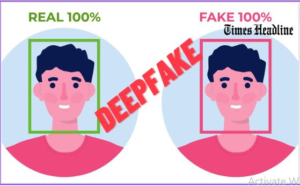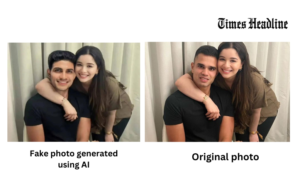By Azra Ali

Artificial intelligence (AI) has drastically changed how we perceived things. With the advancement in technology and AI at one hand things have become easier, simplified and had a positive impact on the productivity. However, at another hand AI has also opened doors for cyber crimes, out of which deepfake has become a serious threat to individual’s identity, privacy and reputation.
Deepfakes, as they are known, employ artificial intelligence tools to create fake images, audio and videos. There have been several cases where the morphed photos of girls and women are used to blackmail them which has taken a serious mental and physical toll on many lives. Now AI has has been deployed to create such photos and videos with much ease and more accuracy and precision.
The dramatic spread of Artificial Intelligence platforms has made it easier to create such persuasive deepfakes. There is a deepfake video of Ukranian President Volodymyr Zelensky asking his soldiers to put down their weapons. Even Indian celebrities like Katrina Kaif and Sachin Tendulkar’s daughter Sara Tendulkar have become a victim of deepfake. These AI generated photos are so accurate and made with precision that it will be impossible for a lay person to realise that the AI generated photo is fake. And this makes this technology more dangerous.

Fact Check of the viral video
A video of Rashmika Mandana has recently gone viral on social media. The problem : It’s not she who is in the video. The woman on whose body her face gas been morphed has also been violated
To verify the authenticity of the viral video, the DFRAC we observed it minutely. We found that the video is a deepfake.
What we found in our investigation
We found that the video is actually a ‘deepfake’ and was created with the help of an AI tool. The actress’s face suddenly changed from the other girl to Rashmika at 0:01 in the video as she was entering the lift. The Collage provided below will show you the difference.
Source of Original Video
The girl shown in the viral video is a British Indian girl, Zara Patel. Moreover, the original video can be seen on her Instagram account which was posted on October 9. It is proved by our investigation that the viral video of Rashmika Mandanna is misleading as it is indeed a deepfake, made by using an AI tool.
Challenges deepfake poses
Detecting deepfake videos is becoming increasingly difficult.Due to advancements in AI content generation, the new generation of deepfakes is almost impossible to spot. This can significantly harm people in the videos, and reduce trust in the credibility of video evidence.
This is complicated by the fact that creating deepfakes or false content in general is not by itself illegal, and may be protected under the Constitution. Many regulations around deepfakes focus on the sharing and dissemination of such content.
A global problem
The relative ease with which such deepfakes can be created and quickly disseminated and consumed, made possible by the wide reach of social media platforms, has become a matter of global concern. More so in times of polarised politics.
Deepfake content is created using advanced AI technology.While it may be used to generate fake videos, it can also be used to impersonate friends or loved ones to trick individuals into sending money to scammers. But there may also be legitimate uses for the underlying technology – to anonymise the voices and faces of journalists and help them remain safe in oppressive regimes. Therefore, a regulatory response that aims to draw a blanket ban is likely to be disproportionate and possibly ineffective.
What does the Indian law say?
In India, the IT Act and related regulations address the content moderation obligations on online platforms. Although this framework would also apply to deepfakes, it is not entirely clear what actions platforms are required to take in this context.
Typically, platforms must remove unlawful content within 36 hours of being notified by a court or government. If an individual is depicted in sexual acts or partial nudity or otherwise impersonated complains, platforms are required to remove such content within 24 hours. They are also required to publish terms of service that prohibit users from uploading content that impersonates other persons, and content that knowingly communicates “misinformation.”
Ultimately, the use of deepfakes echoes the issues we are likely to have with image-based generative AI and the scale and speed of how other kinds of problematic content can spread online.The upcoming Digital India Act, which will reportedly regulate AI and emerging technologies along with online platforms, provids an oppurtunity to address some of these issues.
